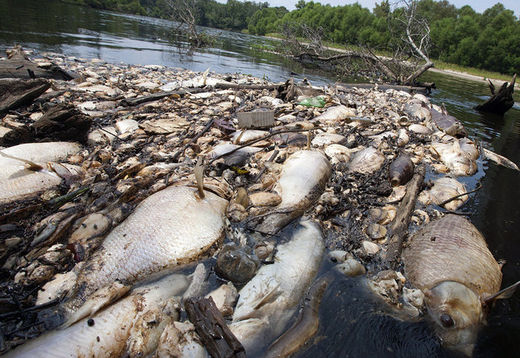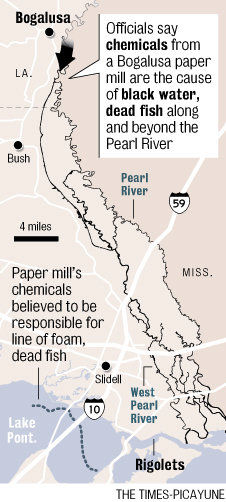
© Scott Threlkeld, The Times-Picayune
The paper mill lnked to a
substantial fish kill in the Pearl River system cautiously admitted responsibility Wednesday, as the trail of dead fish reached
Lake Pontchartrain and a reservoir near Jackson, Miss., was opened in an attempt to flush the pollutants out.
Officials from the
Temple-Inland plant in Bogalusa acknowledged that a mixture of pulp from the paper-manufacturing process and unspecified chemicals poured into the Pearl River late last week at levels exceeding the plant's environmental permits and might have depleted oxygen levels in the Pearl and its tributaries.
Numerous species of fish and shellfish, in large numbers, have turned up dead in the Pearl River system since the weekend as a result.
With thoughts of last year's massive
BP oil spill into the Gulf of Mexico close at hand, government officials mobilized to coordinate a cleanup effort.
"This discharge is doing significant damage to St. Tammany Parish," St. Tammany Parish President Kevin Davis said Wednesday afternoon.

© The Times-Picayune
"We need to assist our citizens whose livelihood depends upon our waterways. The Pearl River is a home to a complex ecosystem that supports fisheries, tourism and transportation."
The Lake Pontchartrain Basin Foundation inspected the lake and spotted some of the same types of dead fish that have scattered the banks of the West Pearl River and adjacent waterways. However, because tests found that oxygen levels in the lake are still normal, foundation officials said the lake is probably not polluted.
Tides probably carried the fish into the lake, and so much more water passes through the Rigolets, which connects the West Pearl, Middle Pearl and East Pearl rivers to Lake Pontchartrain and Lake Borgne, than the river that the discharge is less of a threat, said foundation director John Lopez.
'Black liquor' releasedOfficials are referring to the material in the water as "black liquor," a byproduct of paper-making that has a high pH. Temple-Inland regularly uses acid to balance the black liquor's pH before releasing the material into the river, which its permit allows it do, said Jeff Dauzat, an environmental scientist from the state Department of Environmental Quality.
But Temple-Inland discovered, even before it was released, that the black liquor was exceeding its permitted levels in the plant, said Jay Wilson, vice president of environment, health and safety at the mill.
The substance has moved about 45 miles from its source through the Pearl River system, Dauzat said. He said if tests from his department confirm that Temple-Inland is to blame for the fish kill, it will be the third time a fish kill has been traced to the plant, although previous incidents might have occurred before Temple-Inland took over operations there.
Wilson said Temple-Inland has not been blamed for any past fish kills to his knowledge. Dauzat could not say when the past fish kills happened.
Mississippi officials opened the Ross Barnett Reservoir on Tuesday night, and its usual flow of 200 cubic feet of water per second has been increased to 2,000 cubic feet per second, said Suzanne Parsons Stymiest, spokeswoman for St. Tammany Parish.
However, the reservoir is more than 100 miles upstream from where the fish began dying, and Dauzat said it could take weeks for the water to flush the pollutants out to the Gulf of Mexico.
The best short-term solution is to remove the dead fish from the river because decaying carcasses continue to deplete oxygen from the waterway, Dauzat said.
Temple-Inland has hired a private company to coordinate the initial cleanup, and on Wednesday, Davis negotiated with the company that the majority of the cleanup employees be hired from the affected areas.
Not only does this agreement help those who depend on the Pearl River for their livelihood, but it also ensures a better cleanup, Davis said.
"They know (the river) like the back of their hands and can really assist in the cleanup effort," he said.
State of emergencyThe state of emergency Davis declared for the parish Tuesday night remained in effect.
No one should swim, wade, fish or come in contact with waterways in the Pearl River watershed, the parish president warned. He also advises that no one eat, handle or collect fish or shellfish from those waters and that pets be kept from the water.
The Pearl River splits into three: the East Pearl River, which borders Mississippi; the West Pearl River, where the parish and the governor's office have established a command center; and the Middle River. All include tributaries which make up the Pearl River watershed. Citizens should consider all of these bodies of water as contaminated, Stymiest said.
Davis said the company is absolutely taking responsibility for the fish kill "from a cooperation standpoint." He said the mill is using its resources to clean up the river. As far as reparations go, "we decided we would discuss those issues at a later time. But I had to inform them as president that we believe they are the responsible party," Davis said.
Gov. Bobby Jindal made harsher statements Wednesday.
"I made it very clear that we expect the company to clean up this mess, not only to make sure that it never happens again before they reopen the plant, but also that they've got responsibility to reverse the damage that has been done by this discharge," Jindal said. "He (CEO of Temple-Inland, Doyle Simons) committed to me that they were going to do that. We are going to hold them accountable to that commitment."
Jindal said Temple-Inland has made a commitment to pay its employees even while the mill is closed. Jindal also said there could be federal issues as well, including a possible investigation of violation of the Endangered Species Act.
Reader Comments
to our Newsletter